Written by Benedict Chen
Bangkok is one of the hottest destinations in the world today. But beyond Bangkok’s city lights, 5-star hotels and night markets, there is an absolute trove of culture and tradition – a result of Thailand’s 4,500 years’ worth of history.
Often left uncovered by the average traveller, we’re about to reveal some cultural snippets about Thailand you may have never known.
Also read:
19 unique and magical places to visit in Thailand with fairies, dragons and flaming cliffs
10 water villas in Thailand with stunning water views that will take your breath away!
To fully appreciate the list of 16 unique culture and traditions in Thailand below, there are 2 things you need to be aware of:
1. The ancient people of Thailand were one of the earliest cultivators of rice, and the nation remains one of the largest producers to this day.
2. Introduced as early as 3rd century B.C., Buddhism is the dominant religion in Thailand. So much so that it’s constitutionally required of the King to be Buddhist!
With that out of the way, let’s get started!
1. Rockets For Rain – Rocket Festival (Bun Bang Fai)
Back to the giant rockets, in the Northeastern provinces of Chiang Mai, Yasothon and Isaan, the climate gets pretty dry. As the saying we just made up goes: “without rain, there’s no rice”.
So it is annual tradition for the residents of these provinces to gather up into teams and construct projectiles made of bamboo. These bamboo rockets spanning some 20 feet in length are launched, fuelled by a concoction of sulphur and charcoal, into the air to remind the god Phaya Thaen of his promise to provide rain.
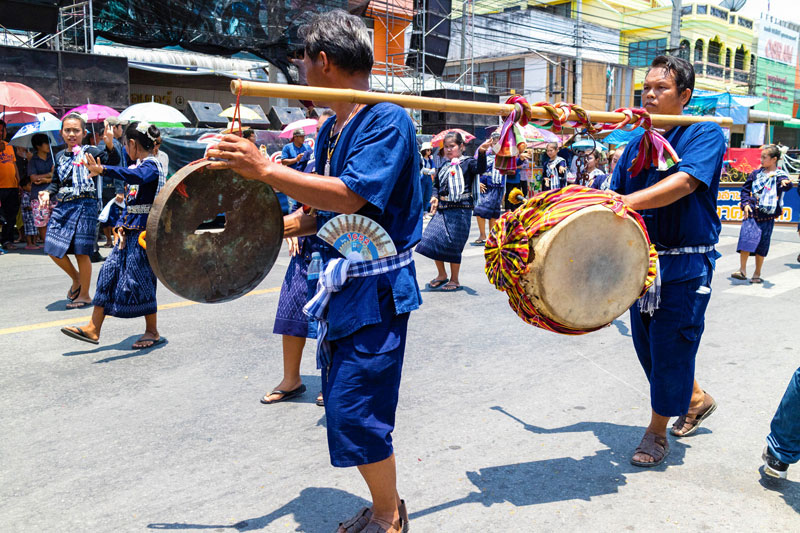
Photo by Sheila Dee
In the spirit of good competition, the team whose rocket flies the highest, farthest and straightest takes home a prize bounty of 10,000 baht.
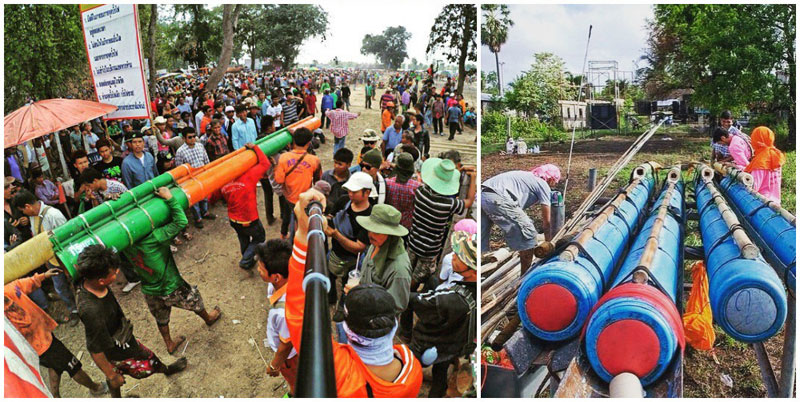
Photo by ta bginner,lovetefl
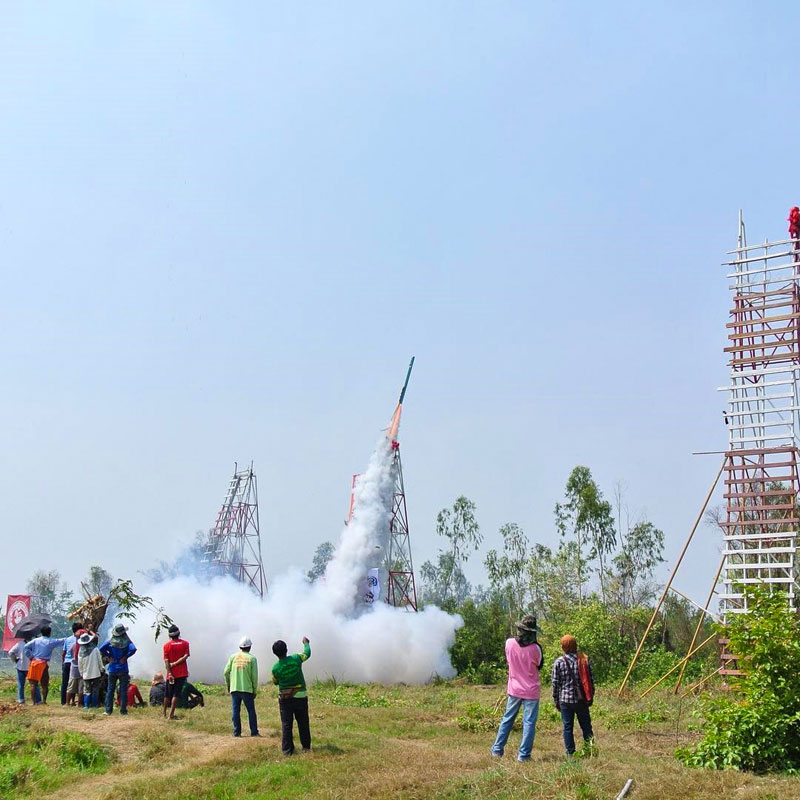
Photo by uem n jpn
Held in May each year, celebrations are rounded off with street performances, cultural shows and beauty pageants. Information on the celebrations can be found via the Tourism Authority of Thailand.
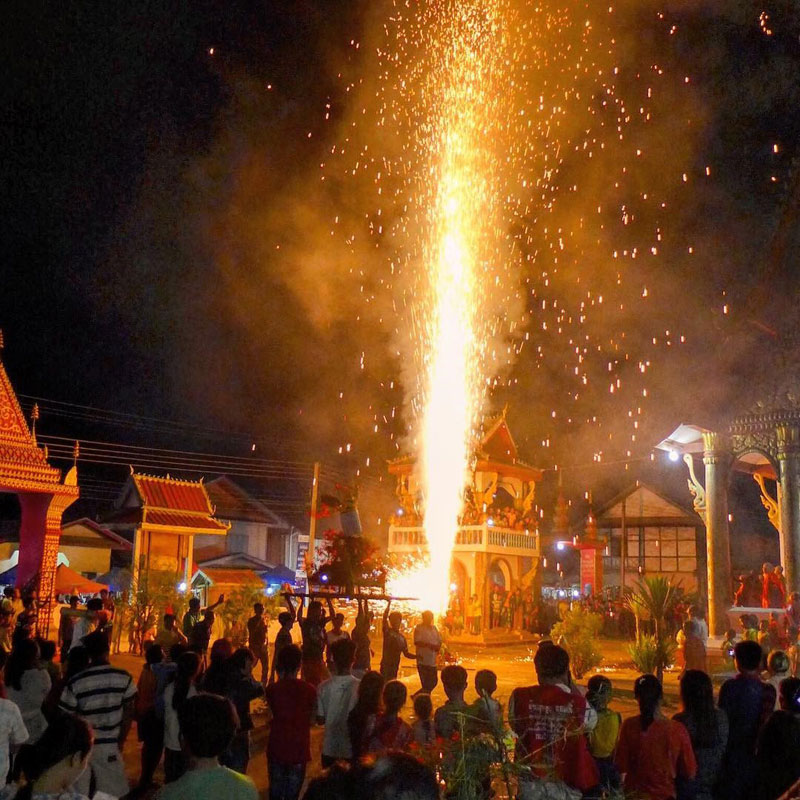
Photo by angetakats
Rocket Festival (Bun Bang Fai)
Address/ getting there: Phaya Thaen Park, Yasothon province, Thailand
When to go: It’s held annually between April to June. Do be sure to check Tourism Authority of Thailand’s event calendar for the dates in advance before heading down!
2. Monkey Business – Monkey Buffet Festival in Lopburi
Lopburi is an ancient city. To provide a context for ‘ancient’: the city was developed during the Dvaravati period that lasted between the 6th to 13th centuries (we are in the 21st)!
Residents of Lopburi include men, women, children … and monkeys.
The citizenship of Lopburi’s monkeys dates back to a time when Hanuman, the monkey deity was believed to have saved a god’s daughter from a demon.
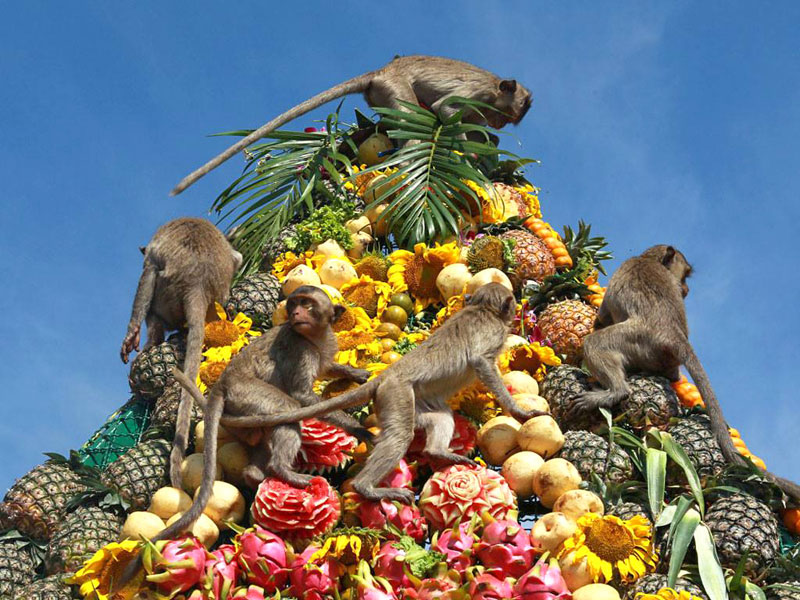
Photo by Dodrey Levy
The monkeys, presumed to be descendents of Hanuman, have taken welcomed residence in Lopburi ever since.
Hanuman was a deity known to bring good fortune and prosperity. It makes absolute sense to find favour with him by honoring his descendents. So every year, a great buffet is held in the local Phra Prang Sam Yod temple, exclusively for the population of approximately 4,000 monkeys.
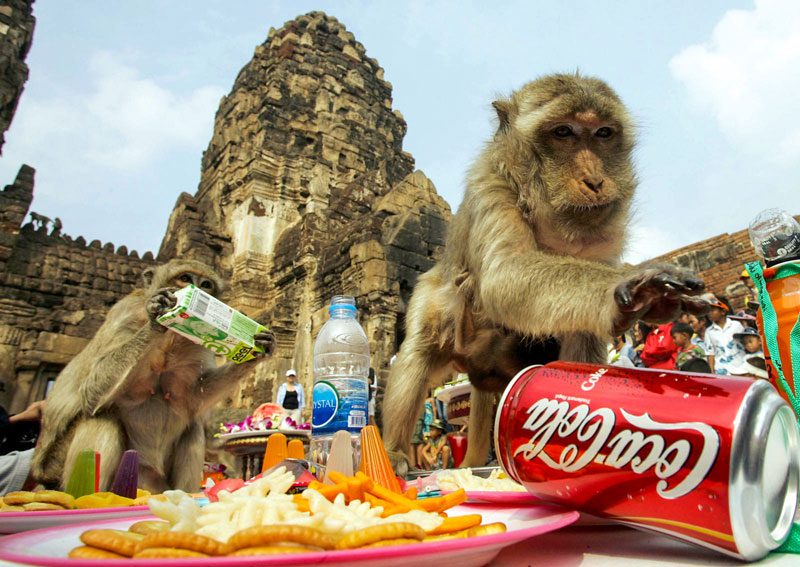
Photo by winder west
Tables of food are laid out as the human population watch the animated primates feast on fruit (and even Coca-Cola), anticipating the good karma that will be bestowed upon them.
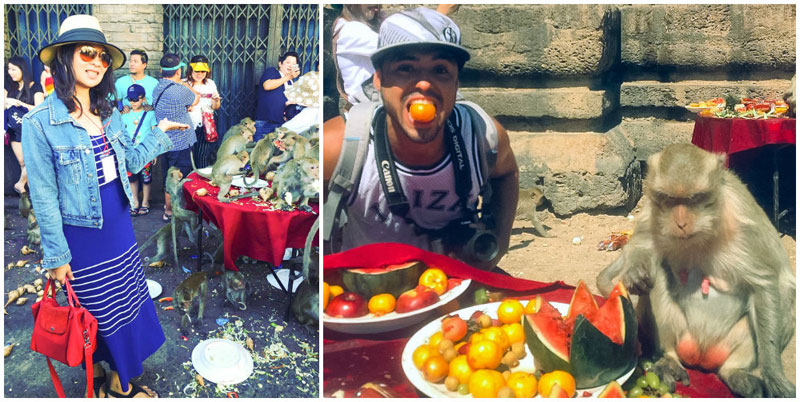
Photo by iamnine98,zukaporai
Nearby the temple, a parade of performers donning monkey costumes can be seen and what would any festival be without music, food and dancing?
Monkey Buffet Festival
Address: Phra Prang Sam Yod (Monkey Temple), 15 Prang Sam Yot Rd, Tambon Tha Hin, Amphoe Mueang Lop Buri, Chang Wat Lopburi 15000, Thailand
When to go: It’s held annually on the last Sunday of November.
3. Light Up The Night Sky – Chiang Mai Yi Peng Lantern Festival
So you read my previous piece about Loy Krathong, and you’re all ready to book your tickets to see the lanterns. What if I told you: you get double the lanterns in Chiang Mai?
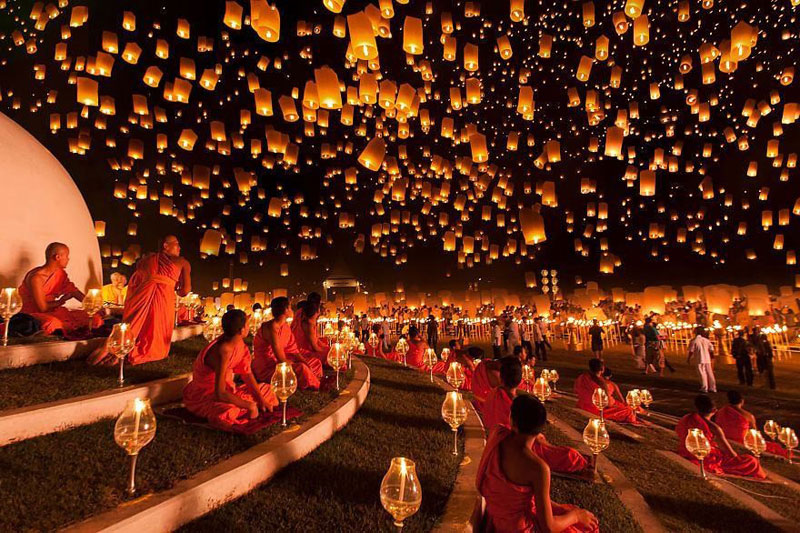
Photo by wondersinyourhands
See, Loy Krathong is a major nation-wide event, but in Chiang Mai, there is another local festival. The Yi Peng Lantern Festival is celebrated one day before Loy Krathong. There are two major differences between Yi Peng and Loy Krathong:
1. Loy Krathong is mainly seen as a communal tribute to the water goddess, while Yi Peng is more symbolic of the individual letting go of anxiety and worry.
2. Unlike Loy Krathong, Yi Peng’s lanterns are paper hot-air balloons (khom loi) that are released into the night sky.
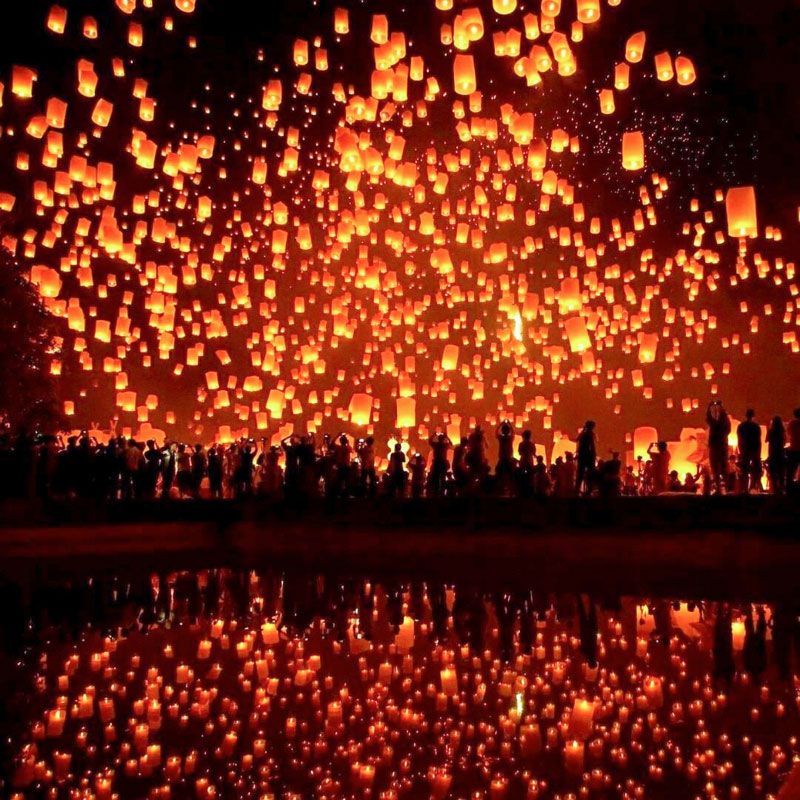
Photo by viajarachiangmai
The result is nothing short of mesmerising with hundreds, if not thousands of lanterns dotting the inky stratosphere.
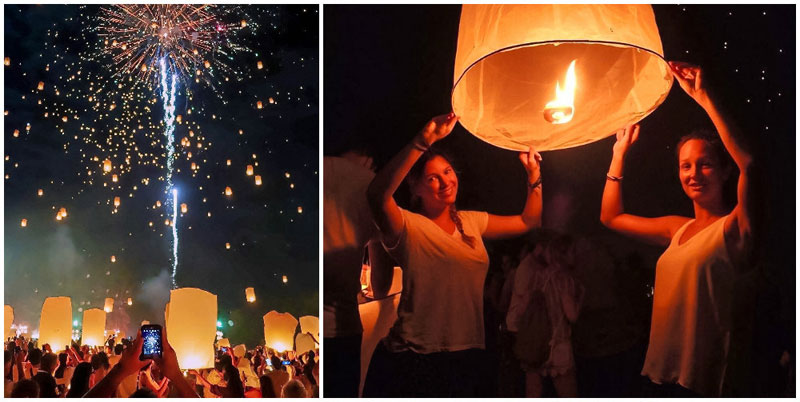
Photo by lena gms,caralovan
Being a localised festival, details of Yi Peng are more difficult to get a hold of, being released only a few weeks before . But this, in my opinion, only makes it all the more gratifying to witness.
Chiang Mai Yi Peng Lantern Festival
Address: Tha Phae Gate, ถนน มูลเมือง ซอย Tambon Si Phum, Amphoe Mueang Chiang Mai, Chang Wat Chiang Mai 50200, Thailand (Yi Peng Lantern Festival is typically celebrated all around Chiang Mai, with Tha Phae Gate being the main area.)
When to go: It’s held annually in mid-November. Do check Tourism Authority of Thailand’s event calendar for more information on dates and event venues before heading down.
4. Great Balls of Fire! – Mekong Naga Fireballs
Thai folklore tells of the existence of mythical serpent-like creatures living in the depths of the Mekong River called the Phaya Naga. The tales hold that the Naga wield divine powers, and are responsible for a strange phenomenon that occurs on the surface of the Mekong.
Each year in October, during a period of 90 days knows as the Buddhist Lent, reddish-pink balls of light can be seen rising from the surface of the Mekong’s waters and into the sky.
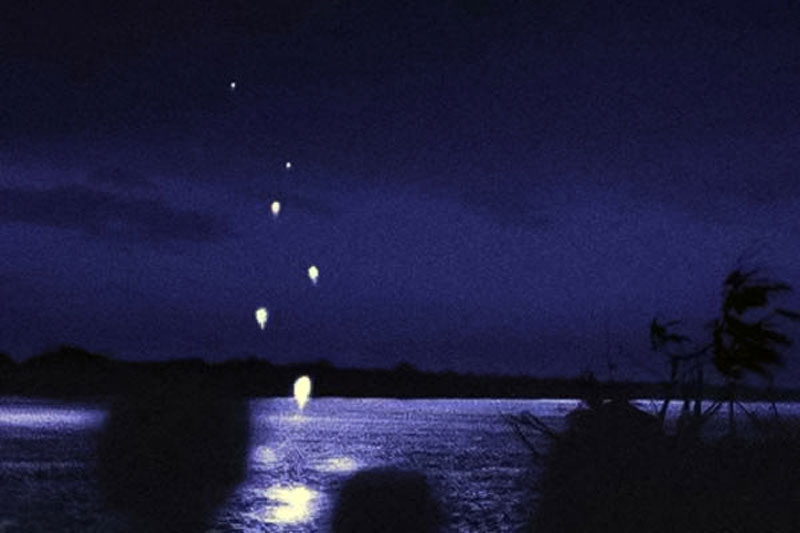
Photo by abovetopsecret
‘Rise’ is the only word that can be used to describe these balls of light, because no sound or explosions or any tell-tale signs of human intervention are anywhere to be heard.
The Naga Fireballs have taken on a viral personality as YouTube videos and social media try to document the allegedly supernatural event. The locals accredit this to the Naga paying tribute to Buddha.
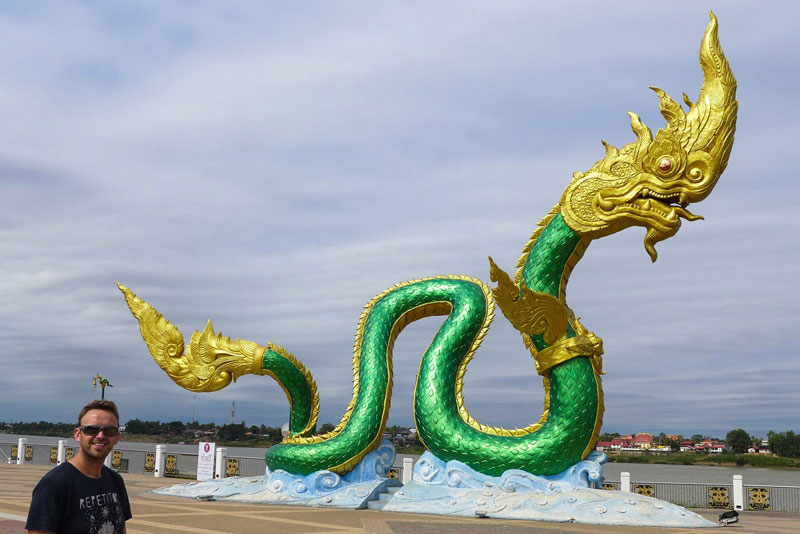
Photo by Thetta reddast
Scientists theorise that this is caused by combustion of flammable sulphur rising out from the Mekong River. You be the judge.
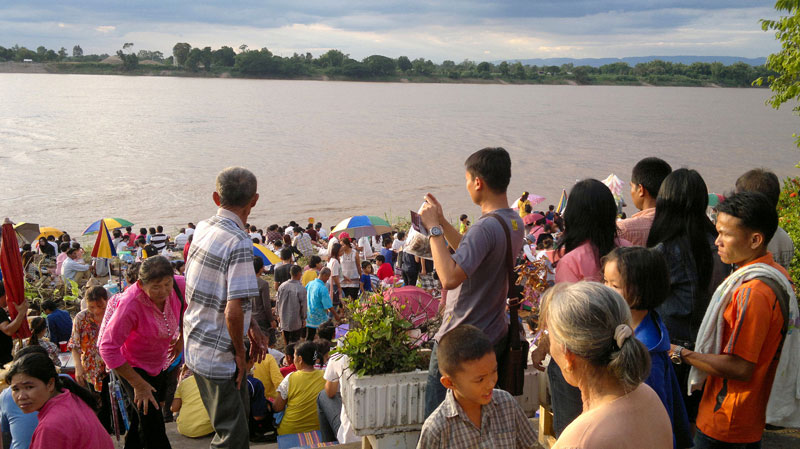
Photo by One Khamrueangsri
Mekong Naga Fireballs
Address: Nong Khai province (in Northeastern Thailand), especially Phon Phisai district (east of Muang Nong Khai)
When to go: It’s held annually in October. Do check Tourism Authority of Thailand’s event calendar for more information on dates and event venues before heading down.
5. Not For The Squeamish – Vegetarian Festival
Thailand’s Vegetarian festival is so named not because it is a celebration for vegans, but rather the abstinence of meat is seen as a form of merit making for good health and purification of the body and mind.
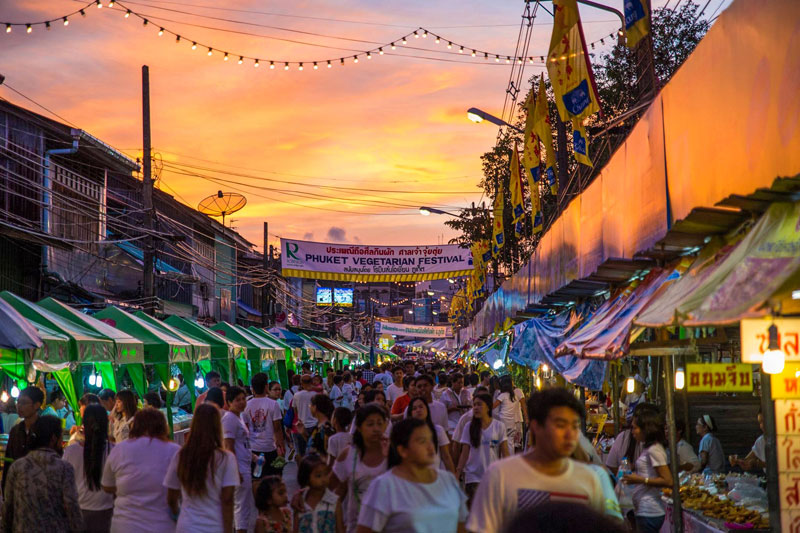
Photo by Joey Santini Photography
Observed on the first 9 days of the 9th Lunar Calendar month, it is generally observed nationwide, but most prominently in Phuket.
During these 9 days, observers stick to a strict diet that is devoid of meat, animal oil and bulbous plants (onions, spring onions, garlic, chives) and tobacco. Restaurants and makeshift food stalls sing to the tune of the festival, tweaking their menus to cater to the requirements of the festival.
If you think this festival sounds docile enough, here comes the juicy bit.
Hundreds of shamans known as ‘ma song’ form a parade, walking through the streets performing feats of self-mutilation to show their devotion to the gods. (It’s quite similar to the Hindu festival, Thaipusam.)
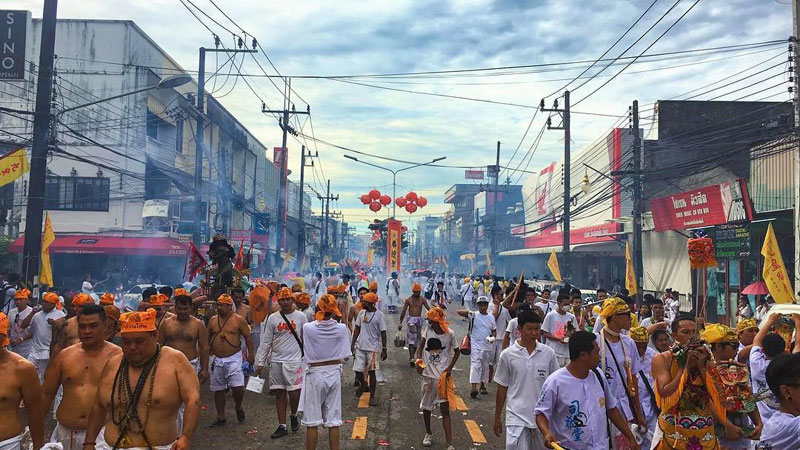
Photo by sinoinnphuket
These acts include the skewering of both cheeks with various sharp objects, walking on burning hot coals and climbing ladders.
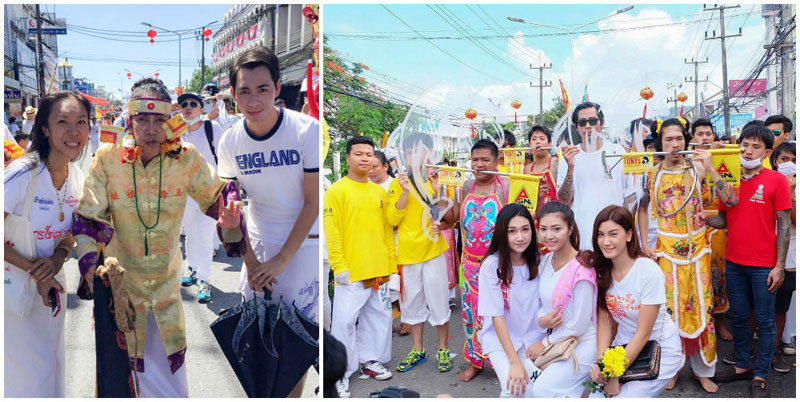
Photo by lee yong_aj,ju_thanty
The evidence of their faith is their coming out of these rituals virtually unscathed! The visual absence of blood and pain validates a shaman’s devotedness, but are no less painful to witness.
Vegetarian Festival
Address: Mainly celebrated in Bangkok, Chiang Mai and Phuket
When to go: It’s held annually between September and October. Do check Tourism Authority of Thailand’s event calendar for more information on dates and event venues before heading down.
6. An Ancient Culture Under Threat – The Mon People of Thailand
The Mon were one of the earliest people to inhabit Thailand. Scholars speculate that Mon people originated from India, Mongolia or China, and settled themselves in the northern regions of Thailand (around the Thai-Burmese border as we know it today).
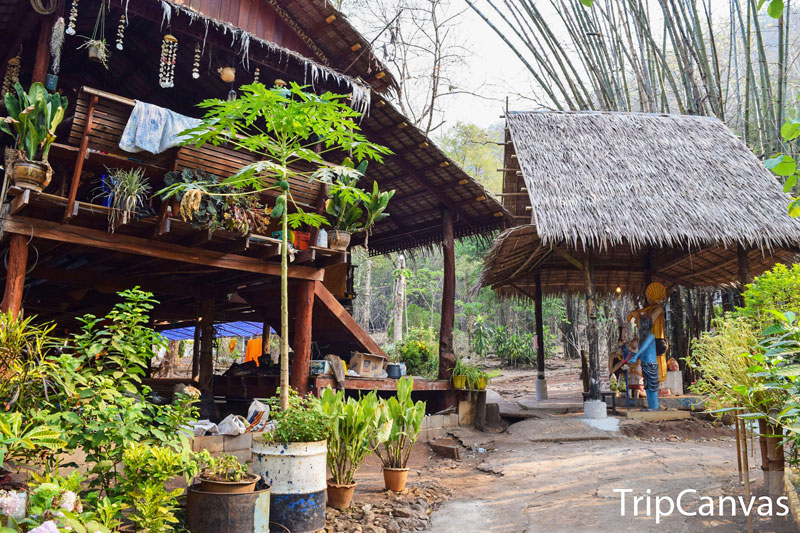
Throughout their embattled history, the Mon people have repeatedly gained and lost sovereignty over their homeland. To this day, they continue to fight for their independence.
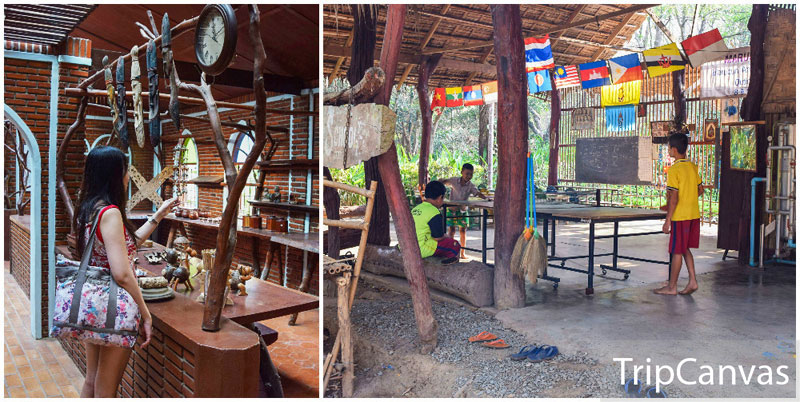
Facing oppression in Burma, a portion of the Mon population fled to Thailand during the reign of King Rama IV, who welcomed them as a source of labour, granting them access to an undeveloped plot of forested land where they established Mon villages.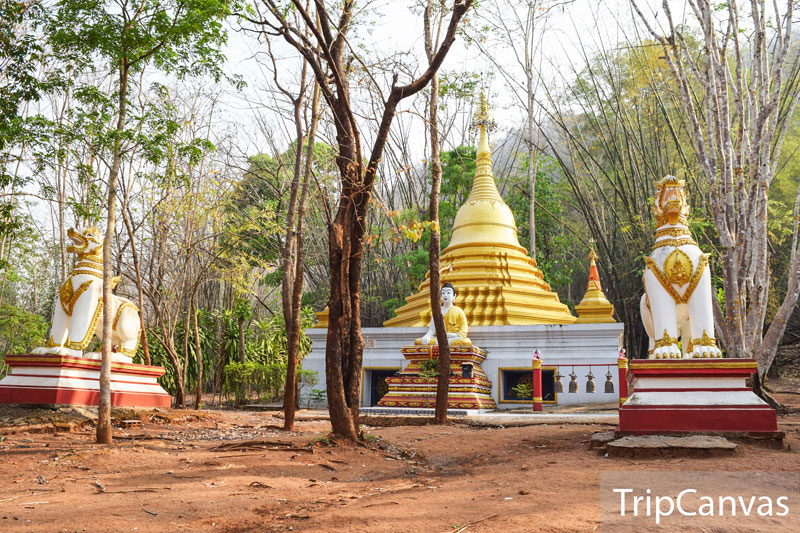
There are actual Mon villages you can visit in Thailand. Make it a trip and stay at River Kwai Jungle Rafts where you’ll not only get to experience the traditional Mon Candle Dance at this eco-resort. You’ll also get to venture out to the Mon Village through a short trek from the resort. There are signs directing you to different places such as the elephant camp, and hotsprings.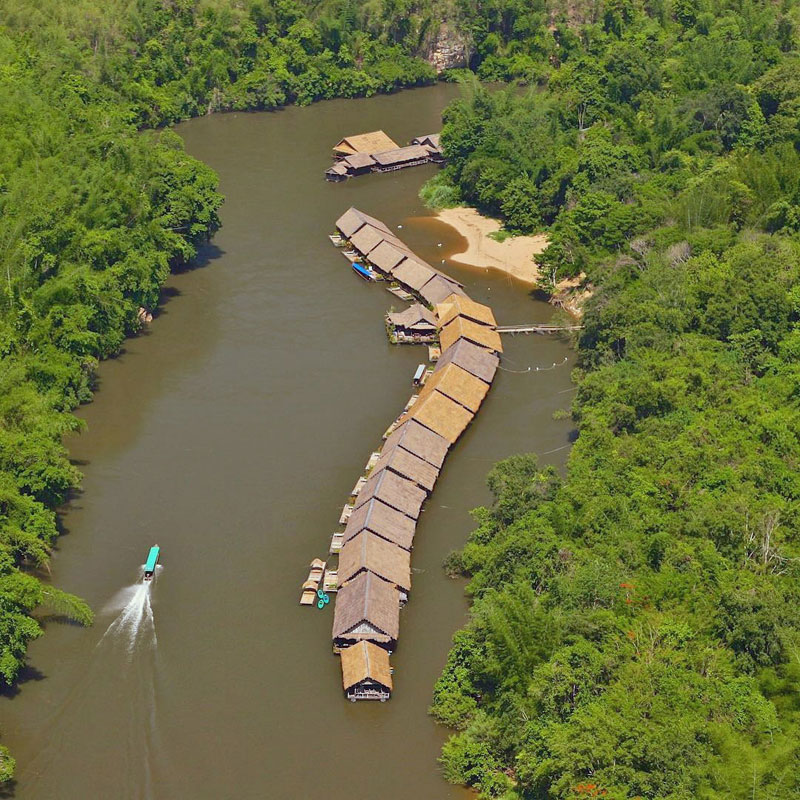
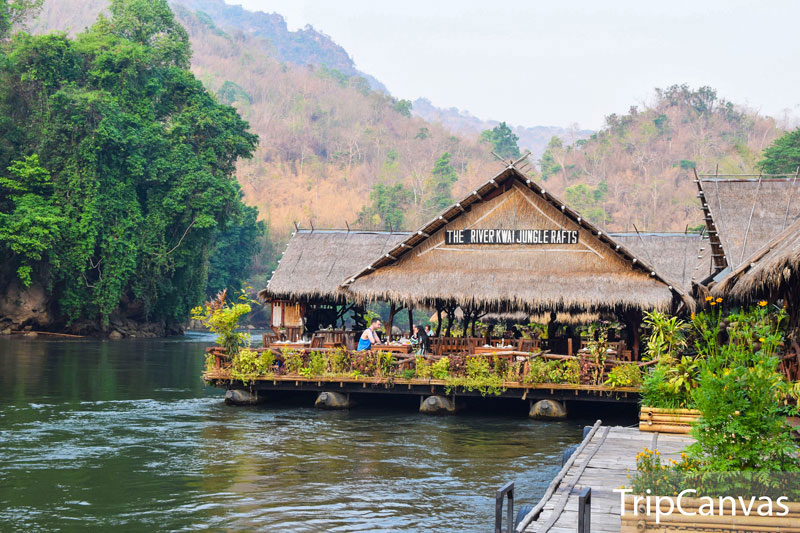
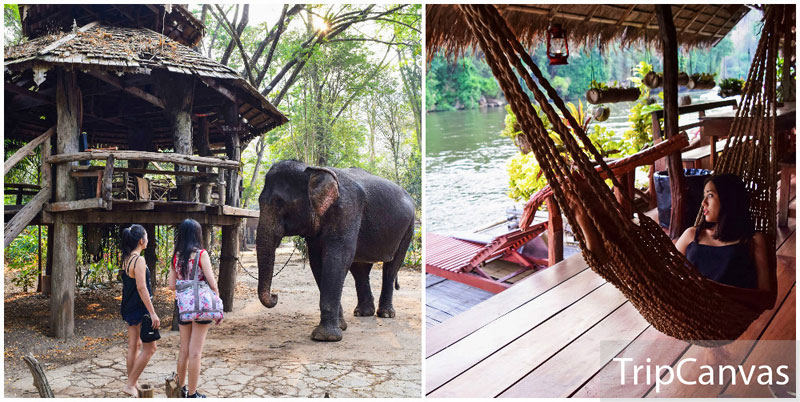
River Kwai Jungle Rafts
Rate: From USD $73 / approx. 2,509 Baht (for Standard Raft)
Address: Sai Yok National Park, Tambon Tha Sao, Amphoe Sai Yok, Chang Wat Kanchanaburi 71150
Contact: 02 642 5497
Website
Check Rate on Agoda 7. Who You Gonna Call? – Ghost Mask Festival (Phi Ta Khon)
Legend has it that Buddha was a prince in one of his past lives. The prince embarked on a long journey and was presumed to be dead. Long story short, he returned to his kingdom alive and there was a great celebration! Hence, the Ghost Mask Festival or Phi Ta Khon has continued every year since.
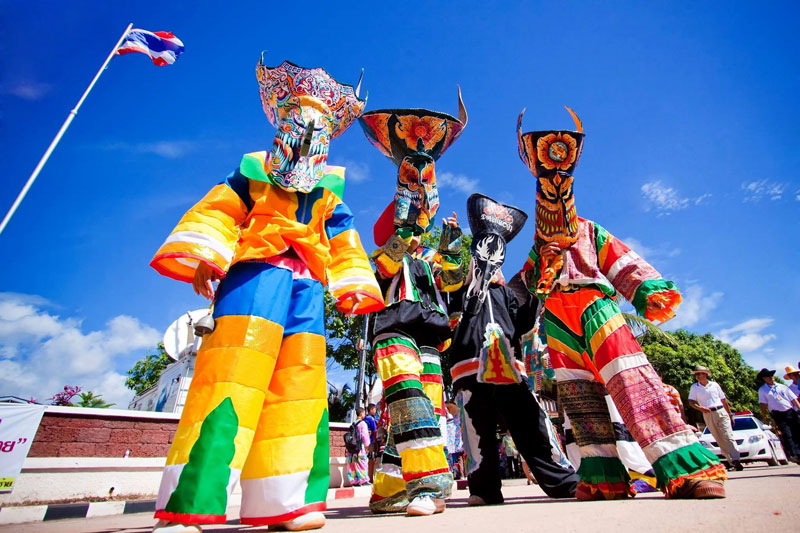
Photo via royaltourthai
Lest you shrug this off as “just an Asian Halloween”, let me assure you: Phi Ta Khon one-ups Halloween, and then some.
First, there are the masks., elaborately handcrafted and downright spooky. Participants throng the streets, donning their prized masks with accompanying costumes, forming a massive spontaneous parade.
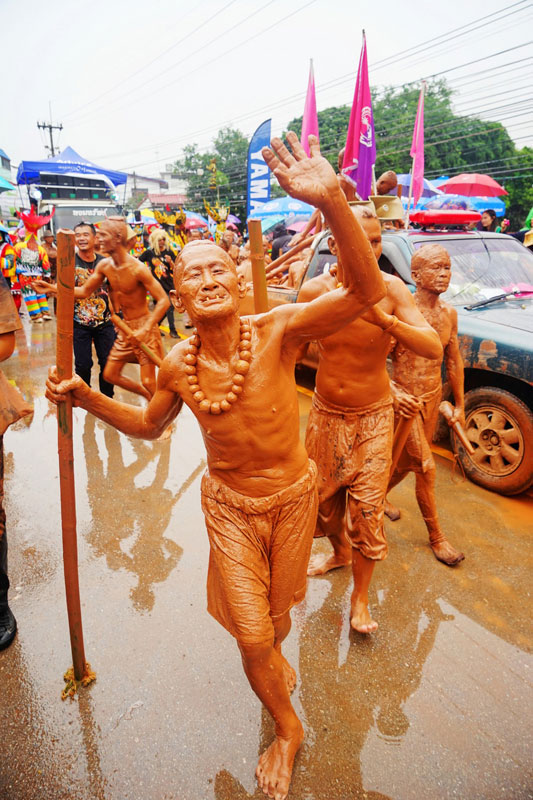
Photo by Judy Lin
Then, there’s the celebrations where all hair (long, short, or none at all) is let down for 3 days in a row. Music, booze, song, dance and other activities are all there for you to enjoy guilt-free! The more fun you have, and the more noise you make – that noise awakens the spirit of the Mun River, Phra U Phakut, which protects the town’s residents.
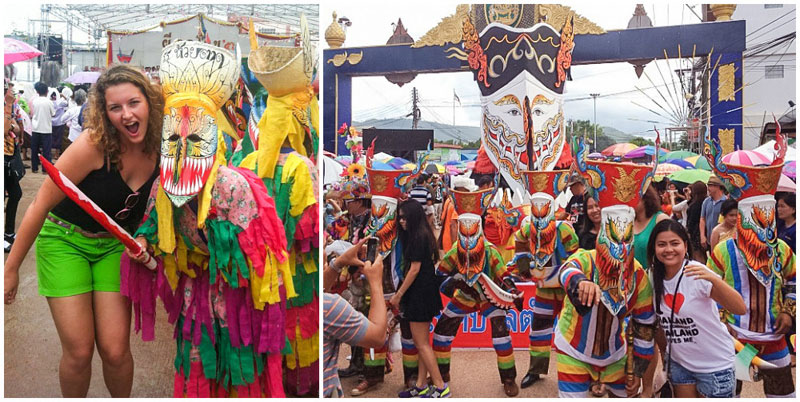
Photo by elpaca72,neus_bkk
Oh, and did we mention the giant rockets?
Phi Ta Khon
Address/ getting there: Phi Ta Khon is held in the Dan Sai district of Loei province in Isan, Thailand
When to go: Phi Ta Khon is held annually between March and July. A medium will choose 3 auspicious days to hold the event, so be sure to check Tourism Authority of Thailand’s event calendar in advance for the dates.
8. Do The Dead Celebrate Christmas? – Salak Yom
A salak is a conical, tree-like structure that can sometimes rise above 2 metres in height. Attached to each colourfully-adorned tree are gifts – everyday household items, food and even cash.
But even Adam would think twice before plucking anything from these trees, because these towers of gifts are meant…for the dead.
The people of Lamphun believe that by dedicating these trees to the monasteries, the gifts that they bear will transcend into the afterlife, and into the possession of their deceased loved ones.
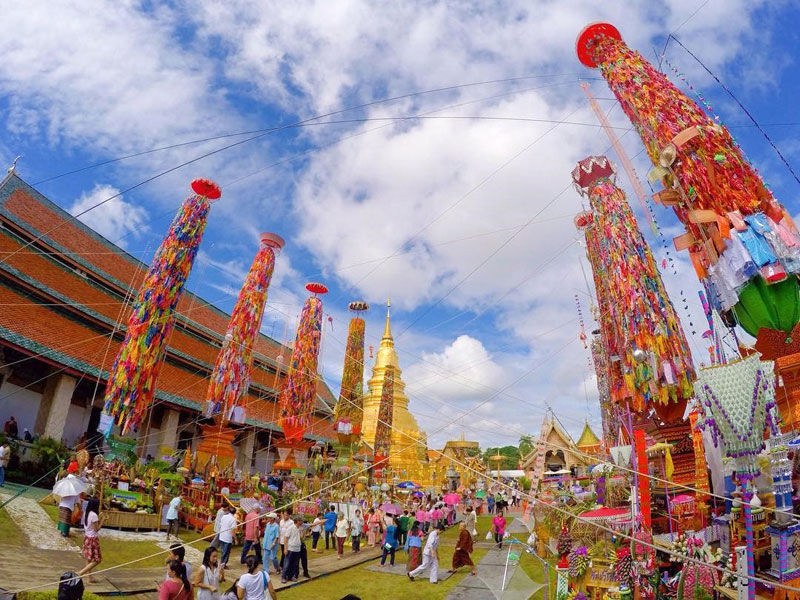
Photo by mmmod niwat
Every September, the Salak Yom procession is accompanied by a good deal of fanfare. Exorbitantly built salaks are paraded through the streets, flooding the whole place with their saturated plumes.
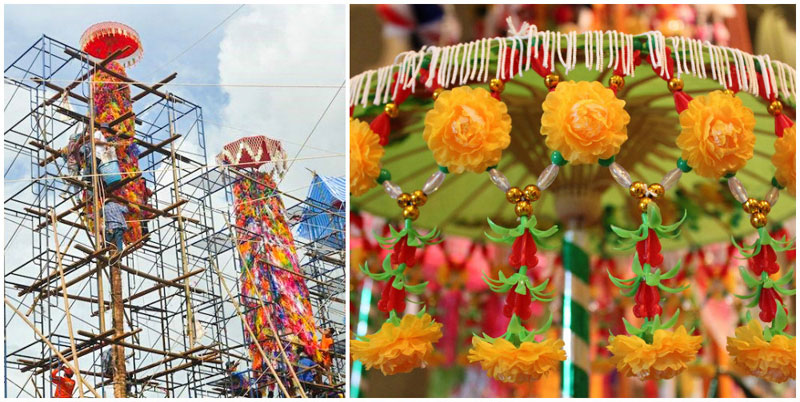
Photo by chiang mai a la carte,Chuansheng-Ji
Trees, presents, year-end-festivities – sound familiar?
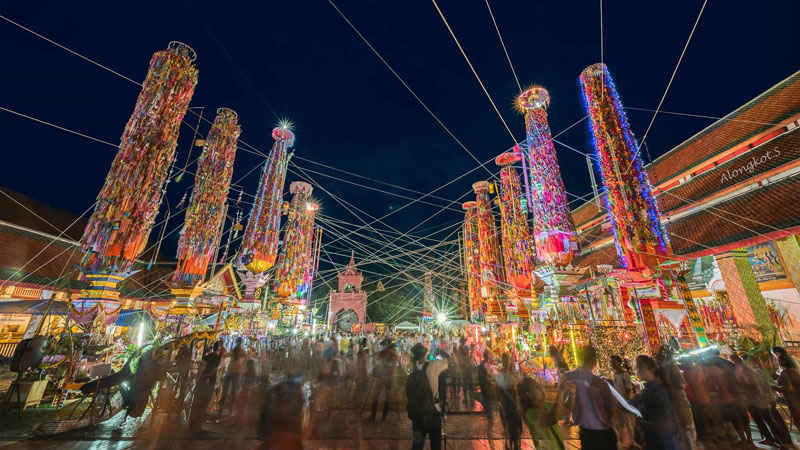
Photo by Alongkot Sum
Salak Yom was actually somewhat of a declining tradition from the 1950s. That is, until it was recently revived in 2003 and even then, annual celebrations are not a sure thing and depend on, for example, the political climate. So I wouldn’t miss any chance to go see the Salak Yom.
Salak Yom
Address/ getting there: Wat Phra That Harinpunchai, 335 O Bo Cho Lamphun Ban Chambon Rd, Tambon Si Bua Ban, Amphoe Mueang Lamphun, Chang Wat Lamphun 51000, Thailand
When to go: It’s held annually in September. Do be sure to check Tourism Authority of Thailand’s event calendar for the dates in advance before heading down! (Here’s an interesting Salak Yom itinerary if you’re keen!)
9. The Most Beautiful Umbrellas You Can Find – Bo Sang Handmade Umbrella Festival
It is said that in ancient times, a venerable monk did the town of Bo Sang (a small village 15km from Chiang Mai) a great deed – by teaching them the art of umbrella making as a source of livelihood.
So grateful were the citizens that they celebrate it with a showcase of the most intricately designed umbrellas. Each painstakingly handcrafted from traditional saa paper, bamboo wood and other exotic traditional materials.
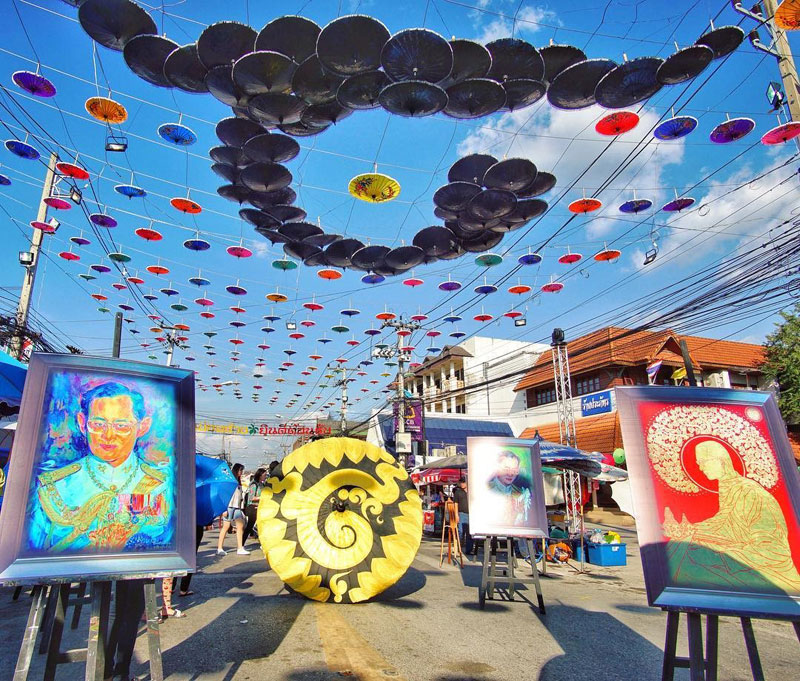
Photo by pergidulu
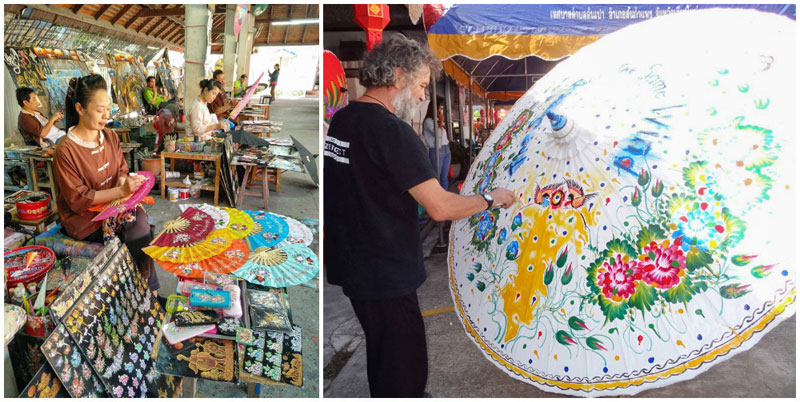
Photo by shasha,Marcia-Somellera
Rumour also has it that this was, the inspiration behind an American singer’s hit song.
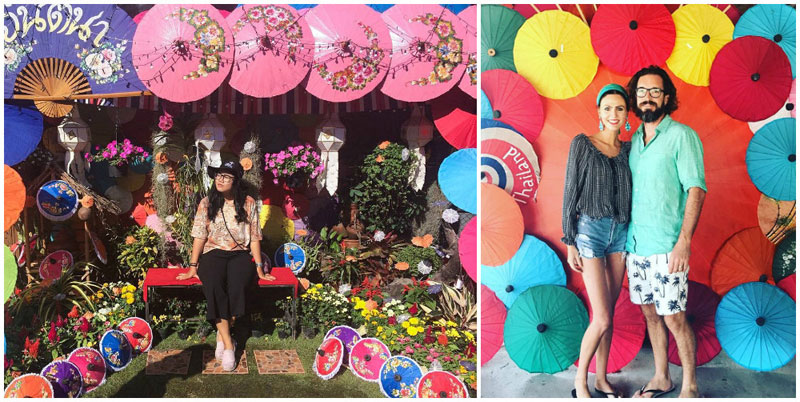
Photo by emagasty,the.b.b.c
Believe what you will, but there’s no denying that the workmanship of these umbrellas are unbelievably stunning! Bo Sang Umbrella Festival takes place around 18-20 January.
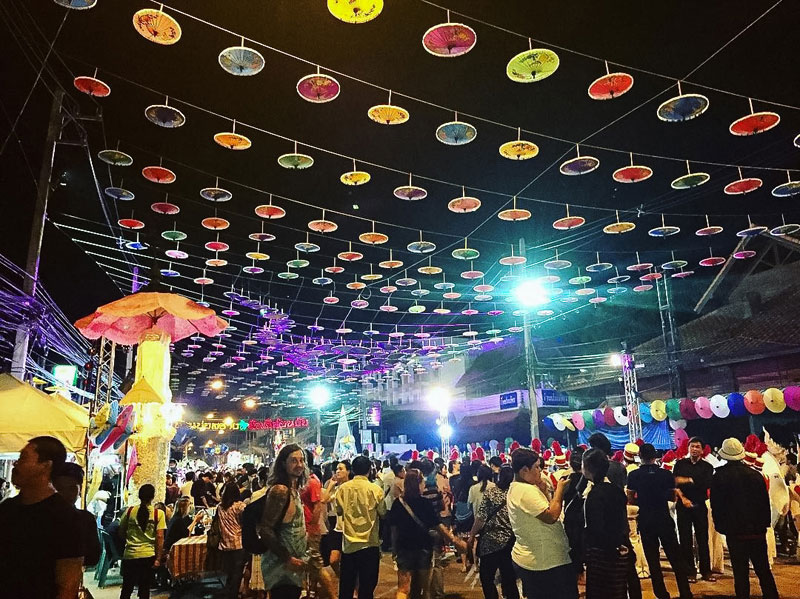
Photo by aveslee
To get to Bo Sang from Chiang Mai, simply hop on a songthaew (passenger truck) from Warrot Market for just 10-20 Baht.
Bo Sang Handmade Umbrella Festival
Address/ getting there: Bo Sang Umbrella Village, Ton Pao, San Kamphaeng District, Chiang Mai 50130, Thailand (It’s 20 minutes outside of Chiang Mai, so you’ll have to take a motorbike or songthaew to get here!)
When to go: Held annually in the third week of January.
10. Water, The Essence of Life – Loy Krathong
Perhaps from an external point of view, Songkran might seem like a colossal waste of precious water.
Enter the Loy Krathong festival, reassuring us that the centrality of water to Thai culture is far from forgotten. Loy Krathong literally means “to float a lantern or little vessel” and it’s an absolute sight to behold.
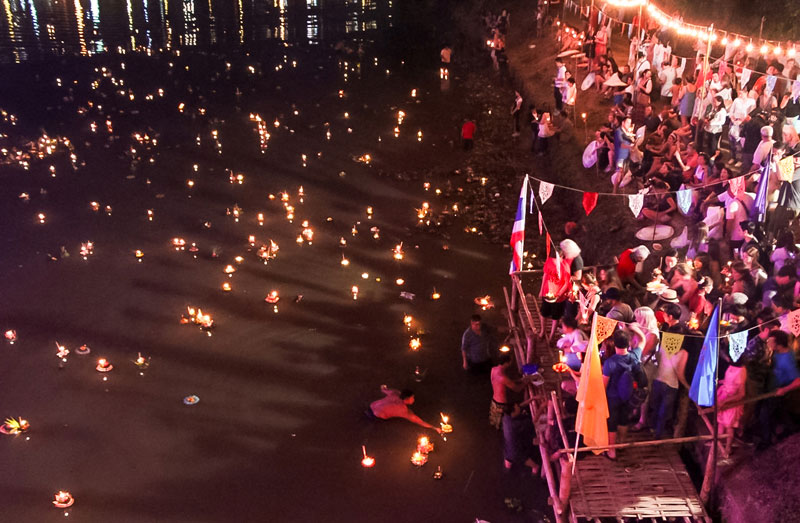
Photo by ToScubaGuy
All throughout Thailand (be it Bangkok, Sukhothai, Chiang Mai or Taak), masses of people take their turn in releasing their krathongs into rivers, lakes, pond until every body of water becomes a sea of tiny flickering beacons of light.
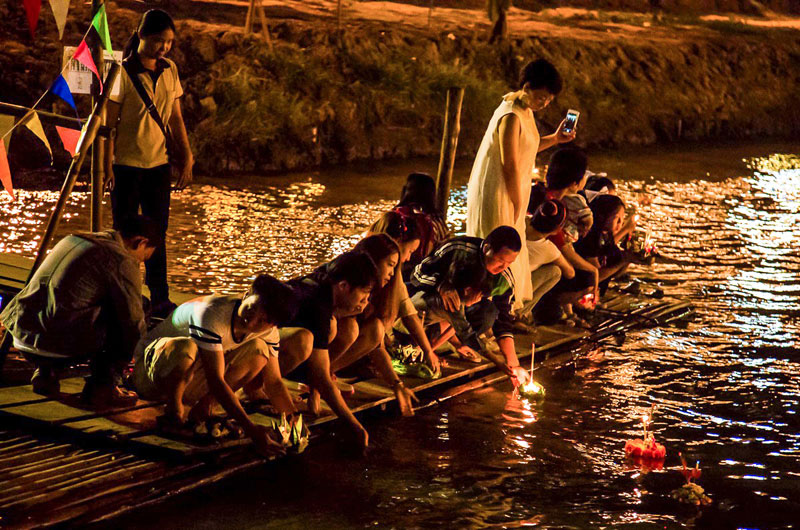
Photo by John Shedrick
All this, as tribute to the water goddess – to thank her for the provision of the life-giving substance, and as penance for wastage and pollution.
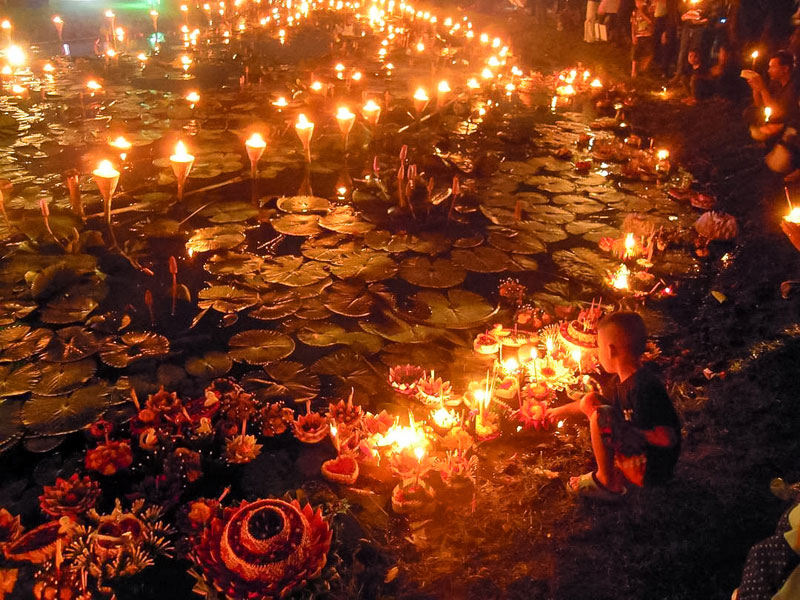
Photo by ravenje666
Loy Krathong is celebrated at the following locations, with each region having its own schedule of celebratory activities:
Loy Krathong
Address: Loy Krathong can be held anywhere. Hotels along Chao Phraya River in Bangkok even host the event along the river, and other hotels also host Loy Krathong at their pool area. If you’re wondering which locations are great for celebrating Loy Krathong, Bangkok, Ching Mai, Sukothai and Taak are great.
1. Bangkok – Chao Phraya River
2. Chiang Mai – The Old City Moat (ku muaeng derm)
3. Sukothai – Sukothai Historical Park
4. Taak – Ping River
When to go: It’s held annually in November. Do check Tourism Authority of Thailand’s event calendar for more information on dates and event venues before heading down.
11. Elephants Never Forgotten – Surin Elephant Festival
The Thai have an intimate relationship with elephants. Before the invention of army tanks, farming tractors and bulldozers, and the subway, there were these big friendly giants.
Elephants were used for battle. Elephants were used in agriculture and construction. They even travelled by elephant. Statues of Ganesha, the Hindu elephant-faced god, are not uncommon throughout Thailand.
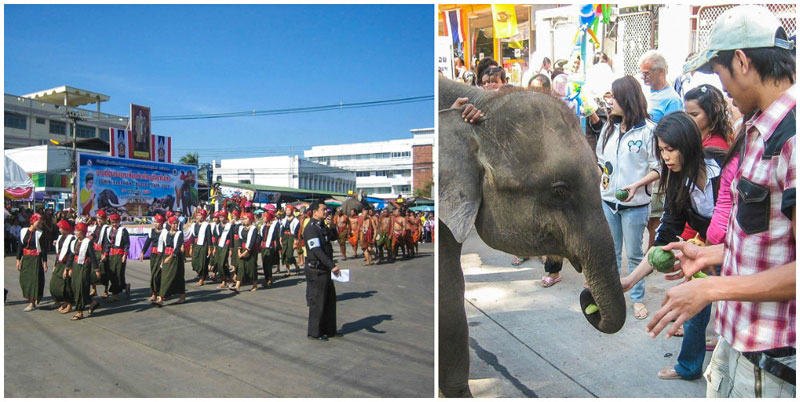
Photo by David-B
In Surin, elephants are celebrated more than any other province in Thailand. In November, domestic elephants are paraded through the streets which are lined from end to end with fruit and vegetables. Essentially, an all-you-can-eat buffet for Surin’s beloved beasts.
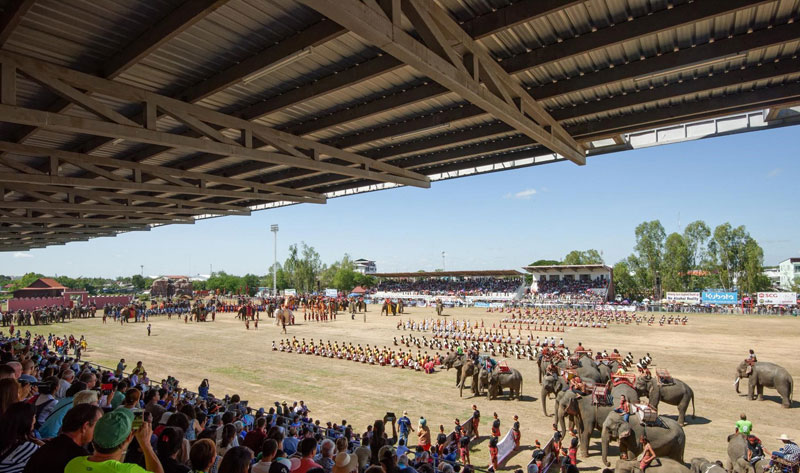
Photo by Ribeiro_dos_Santos
Accompanying the elephant contingent are marching bands and massive ornamental floats built so high they threaten many a phone line. The day is rounded off with a special blessing ceremony and elephant shows.
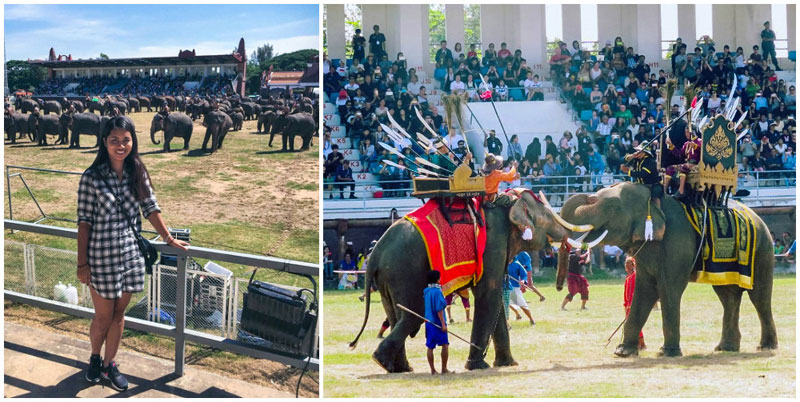
Photo by chilli noodle,koy story
The annual event is both a tribute to the elephants for their partnership in the livelihood of the Surin community, and a stark reminder that these endangered companions are to be cherished.
Surin Elephant Festival
Address: Si Narong Stadium, Nok Mueang, Mueang Surin District, Surin 32000, Thailand
When to go: It’s held annually on the third weekend of November. (You can find out more from the Surin Project Facebook Page!)
12. Supernatural Tattoos Of Blessing – Sak Yant Festival (Wai Kru)
In ancient times, Thai soldiers received magical tattoos known as Sak Yant from the Buddhist monks in Wat Bang Phra temple. They believed these tattoos would grant the soldiers impenetrable skin, good luck and healing powers – ultimately leading to returning victorious from the battlefield.
Modern devotees still visit the temple to receive these magical tattoos. Only holy monks are allowed to administer the tattoos by way of sharpened bamboo tips. Even the ink used is a special concoction made from ingredients such as charcoal and even snake venom!
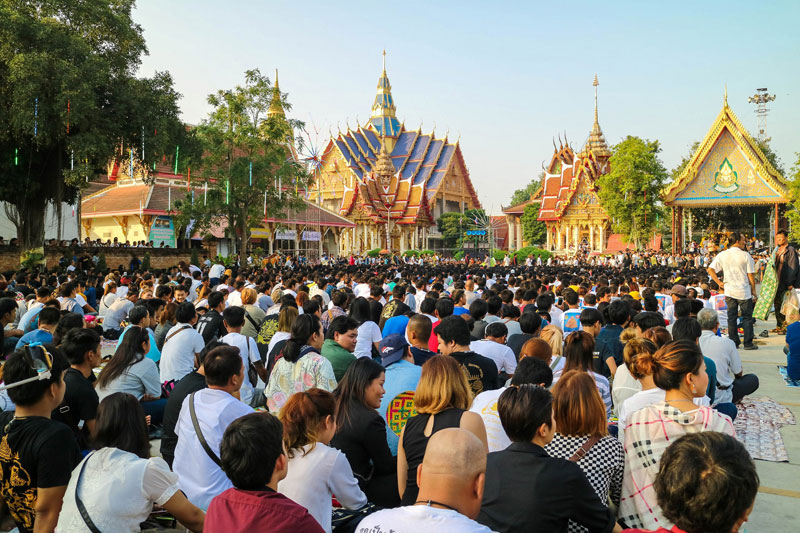
Photo by Sheila Dee
The only kink in the tattoos’ ink is that their magic is known to wear off over time. So every year during the Sak Yant Festival, mobs of devotees make a pilgrimage to the temple to restore their tattoos’ magical powers.
During the procession, devotees sit cross-legged, deep in meditation under the scalding sun awaiting their turn to be re-blessed by the temple masters. Slowly, many devotees experience entering a state of trance – appearing to be possessed by the respective deities whose mark their tattoos adopt.
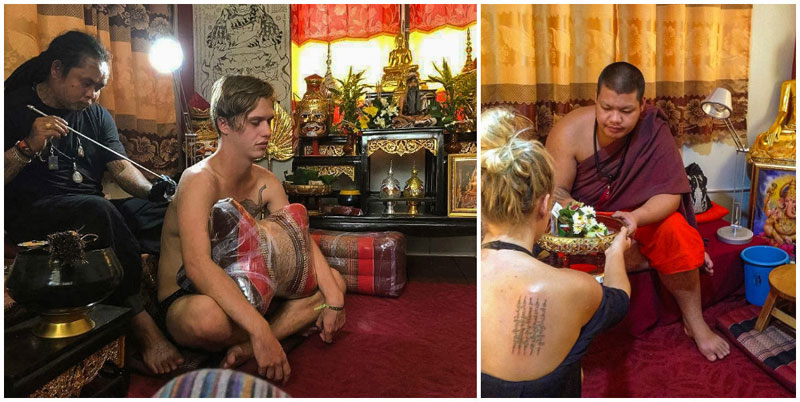
Photo by maxmckeogh,livewtravelf
The reputation of these tattoos have spread internationally as you will find a melting pot of devotees – Thai, Chinese, Indian, Caucasian. Notably, Angelina Jolie also received such a tattoo.
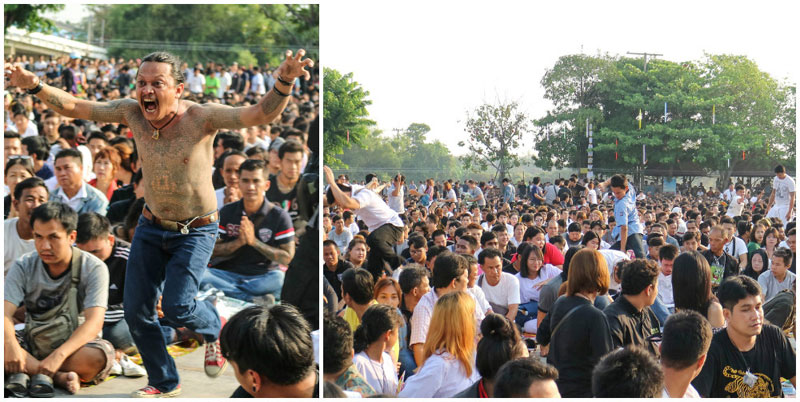
Photo by Sheila Dee
The festival happens around March, but the date changes every year and is only announced a couple months before so keep an eye out!
Sak Yant Festival (Wai Kru)
Address: Wat Bang Phra (Sak Yant Temple), Moo.3, Wat Lamut-Nara Phirom Road, Tambon Bang Kaeo Fa, Amphoe Nakhon Chai Si, Nakhon Pathom, 73120, Thailand
When to go: It’s held annually in March. Do check Tourism Authority of Thailand’s event calendar for more information on dates before heading down.
13. Thailand’s Answer to Madame Tussauds – Khao Phansa
Therevada Buddhist monks spend 3 months in a retreat called Vassa, or more casually called Buddhist Lent. During this period monks will remain in their temples, spending the time in deep meditation.
In days of old the people would come and offer candles to the monks. This form of goodwill was much appreciated in those days, since light was needed to illuminate the temple chambers.
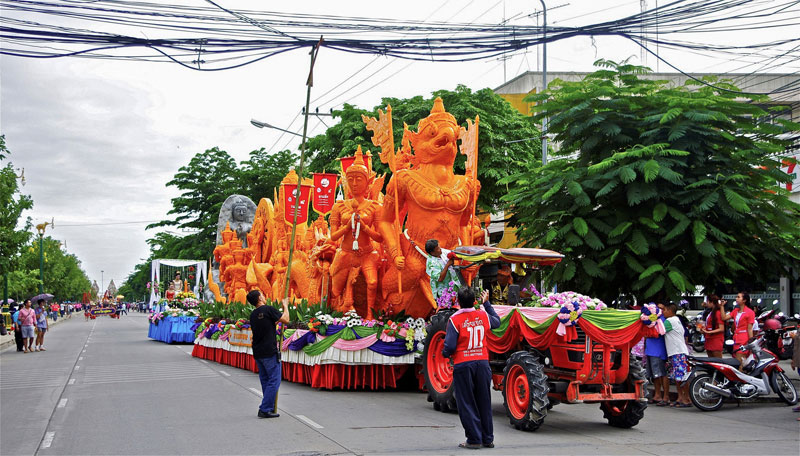
Photo by Christian Sorand
As electricity became readily available, the candles became more symbolic than functional and took on a more ornamental form. People began to carve intricate designs on coloured wax and as the focus on presentation grew, so did the size of the candles.
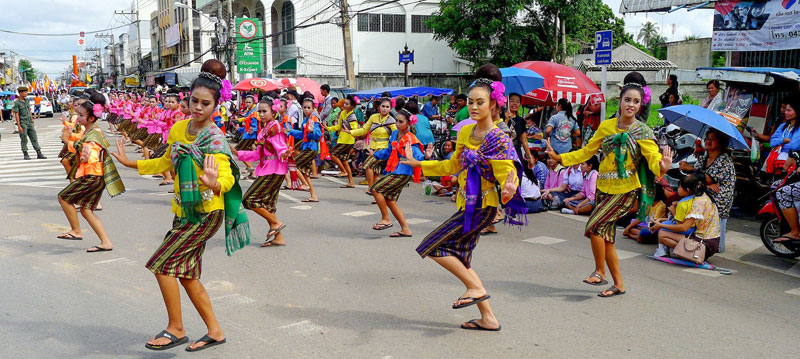
Photo by Larry Oien
Soon candles became obsolete, but the spirit of the practice lives on in the Khao Phansa Candle Festival.
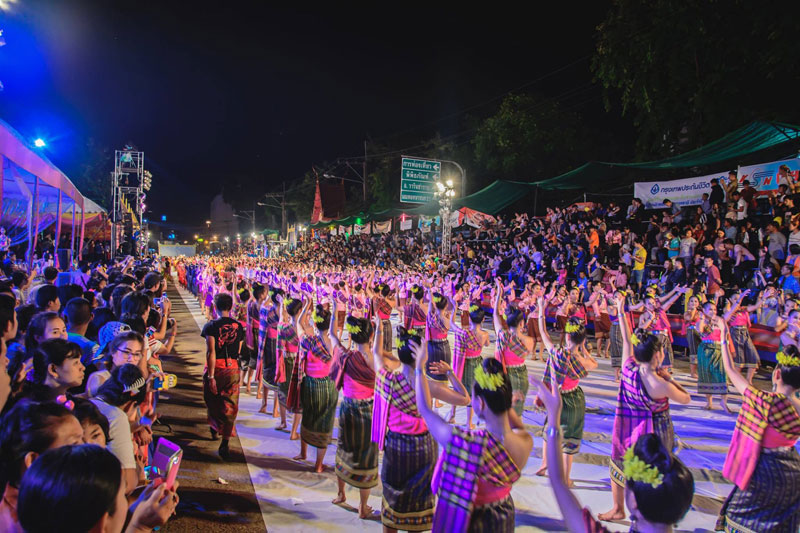
Photo by Pongpun Sriprom
Now, calling them wax candles would be an understatement. ‘Statues’ is more like it.
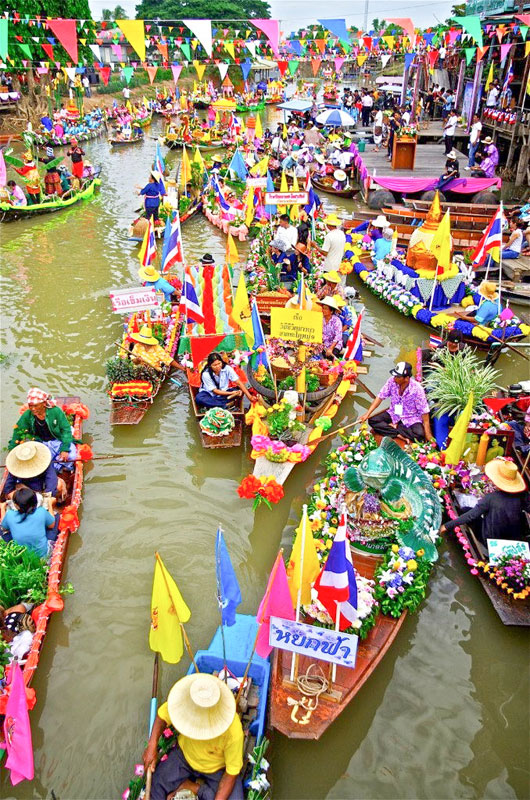
Photo by Christian Sorand
Locals and people from all over the world come to try their hand at making the best wax carvings during the Candle Festival. Feel free to come join the fun! Whether you’re just experiencing it, or trying your hand at candle carving, it’s all great fun!
Khao Pansa
Address: There are many venues and different events celebrating Khao Pansa all throughout Thailand. To have exact locations on where to celebrate, please check Tourism Authority of Thailand’s event calendar.
When to go: It’s held annually in July. Do check Tourism Authority of Thailand’s event calendar for more information on dates before heading down.
14. The Last of Their Kind – Monk’s Alms Bowl Village
Gallivant down Soi Ban Bat and the clingety clangety of metal colliding is sure to capture your attention.
As your curiosity eggs you to investigate, you will discover a small group of people engaged in their craft, bending sheets of metal and welding the edges together to form a sphere-ish contraption.
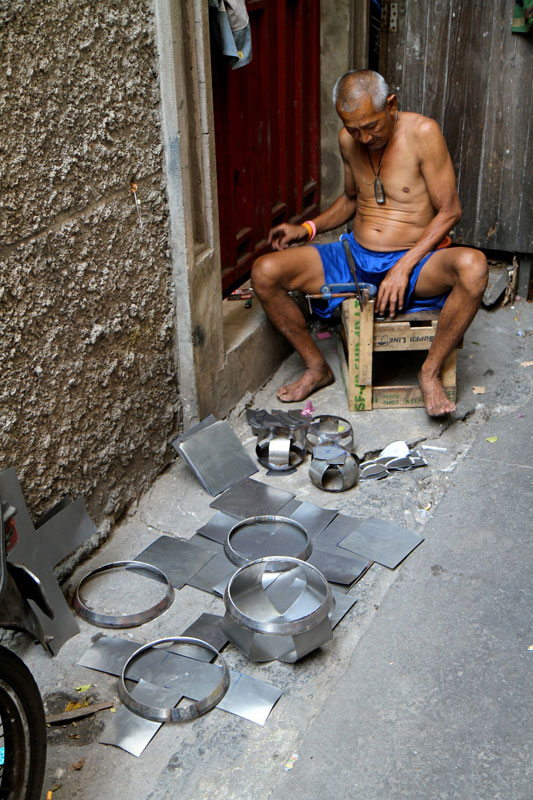
Photo by Jason Eppink
What these metal vessels are, are alms bowls.
For the uninitiated, the Buddhist devotee’s journey to nirvana begins with the giving of alms – donations of money, food and equivalent items to monks who would receive these charitable gifts in alms bowls.
Where alms bowls were traditionally handmade, the trade has given way to mechanisation, replaced by cheaper factory-made substitutes. As a result, the number of artisans has greatly dwindled.
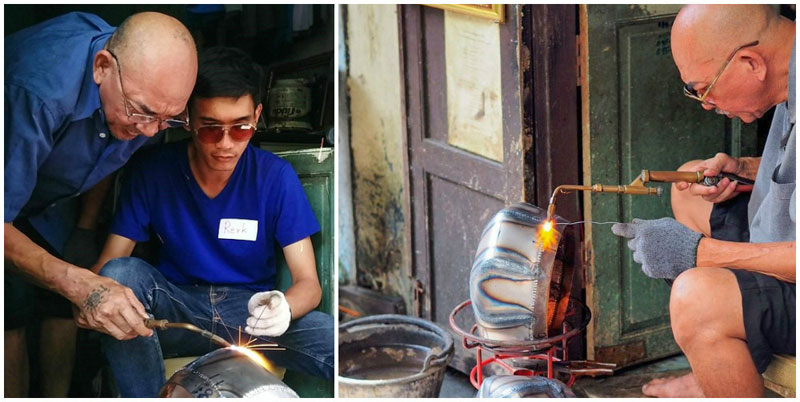
Photo by namotasa,priwziest
With the advent of tourism and the regulation practice of some monasteries to accept nothing less than true-blue authentic handmade alms bowls, the trade has seen a mini revival of sorts. Just enough to sustain the few craft communities that make them for a living.
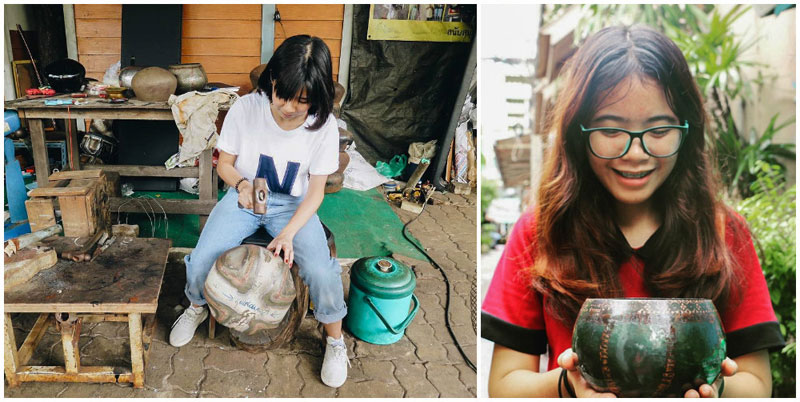
Photo by ntwd,looktan_mpt
Creating an alms bowl by hand is no mean feat and even a rushed job will take all of 5 days. So if you want one, it really is ‘while stocks last’. Soi Ban Bat is connected to Bamrung Mueang Road in Bangkok.
Monk’s Alms Bowl Village
Address: Bamrung Meuang Rd, Soi Ban Bat Khwaeng Ban Bat, Khet Pom Prap Sattru Phai Krung Thep Maha Nakhon 10100 Thailand
When to go: Go down anytime between 11am to 4pm
15. Watch eerie glowing boats glide past on the river – Lai Reua Fai
Ever heard of the Illuminated Boat Procession of the Isan? It’s a wondrous sight to behold, as these illuminated boats light up the dark night and glide past on the Mekong River.
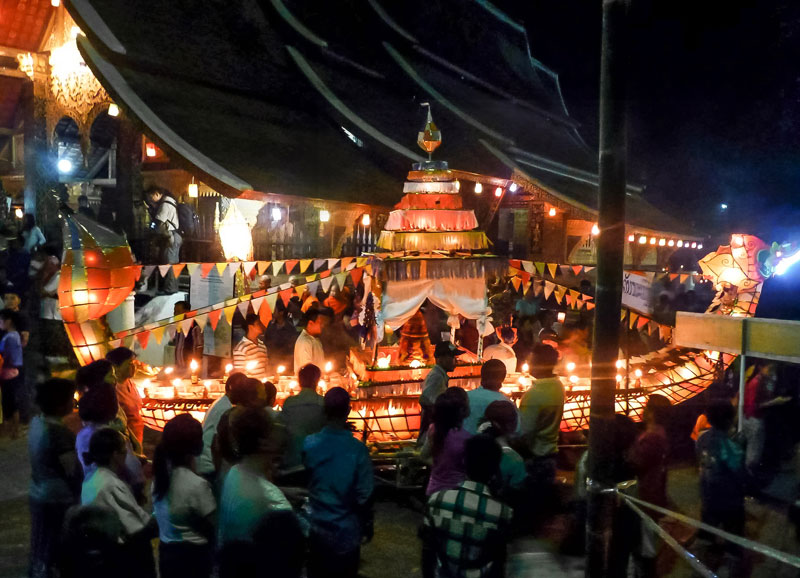
Photo by apaillous
An ancient tradition of the North Eastern Isan people, this festival serves as a time for locals to pay their respects to the goddess of the river.
Apart from the incredible sight, other activities including street parades, illuminated boat-making exhibitions and cultural performances are available too!
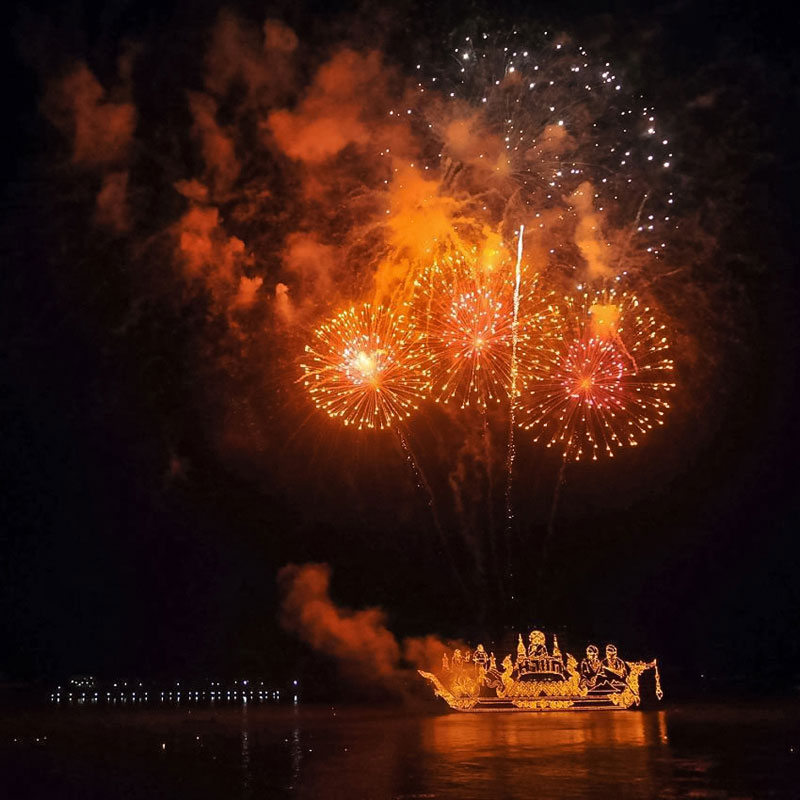
Photo by kyu2you
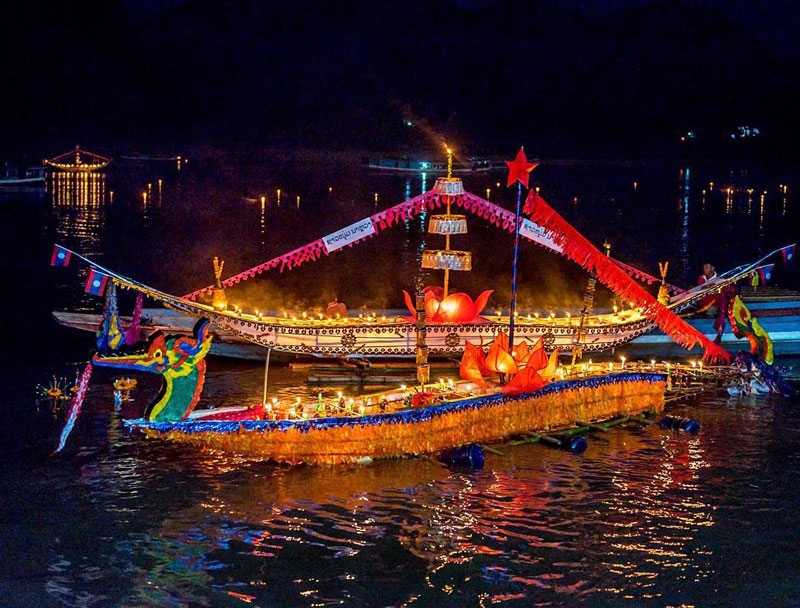
Photo by sophtravels
Lai Reua Fai
Address: Nakhon Phanom
When to go: It’s held annually in October. Do check Tourism Authority of Thailand’s event calendar for more information on dates before heading down.
Special mention
Songkran Festival and Muay Thai fights might not be a hidden tradition/culture of Thailand, but they’re definitely not to be missed. Having been around and celebrated for years and years, both traditions deserve a special mention!
1. You Will Get Wet – Songkran Festival
While the rest of the world celebrates New Year’s Day, the Thais celebrate Songkran. That’s just about where the similarities end.
From April 13-15, the whole nation basically takes place in mass mutual water splashing (there’s no elegant way to put it). Water guns, water bombs, buckets, hoses, trucks. You name it, they got it.
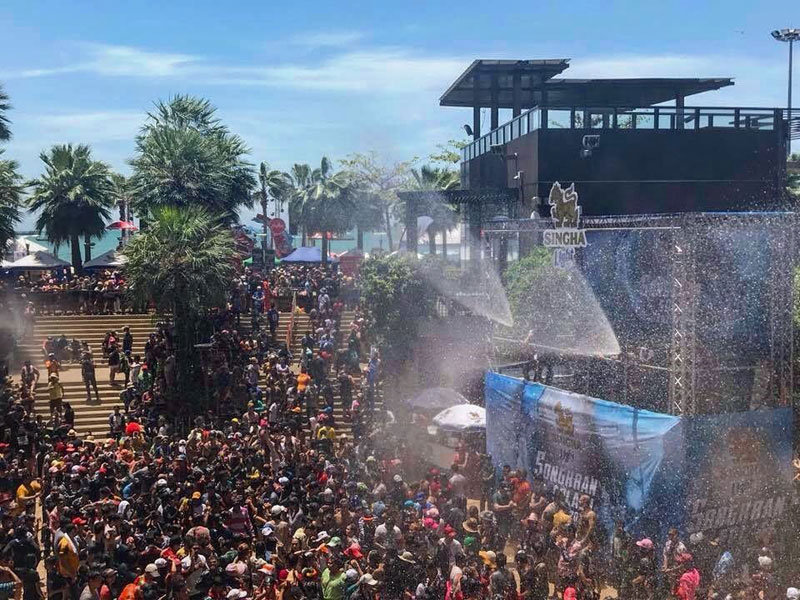
Photo by atithtaya
“Why”, you ask?
The Thai people believe that water has the ability to cleanse in a spiritual sense. Generally common among Asian cultures, the new year means ushering-in the new and moving on from the old (past).
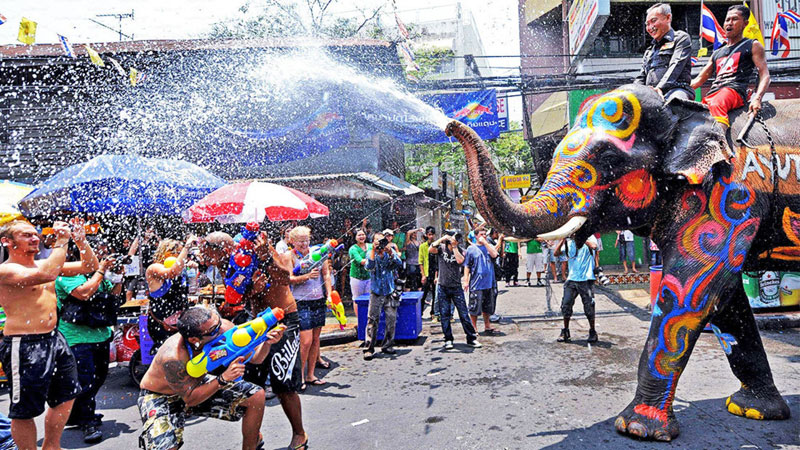
Photo by travelplanetin
So the next time a Thai friend bombards you with an ice-cold stream of water, it’s their way of saying “let bygones be bygones; the best is yet to come”.
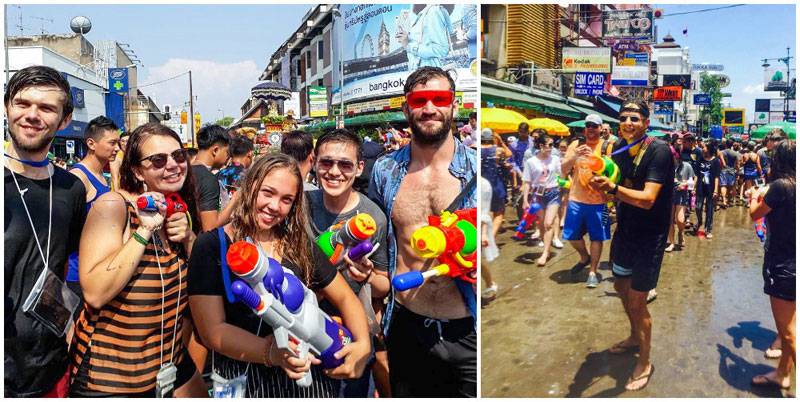
Photo by ldnbrandt,marcel _lecram
Well that, and because it’s a whole load of fun!
Songkran
Address/ getting there: Songkran is celebrated everywhere in Thailand. For starters, if you’re in Bangkok, you may check out certain locations such as Silom, Khao San Road and Phra Pradaeng District among others.
When to go: It’s held annually on 13 to 15 April. However, do check Tourism Authority of Thailand’s event calendar for more information in advance before heading down. You will find updated dates and event venues there too.
2. The Art of War – Muay Thai
Most of us know and understand Muay Thai as the traditional Thai martial art and as an international sport. But what can be witnessed for entertainment and competition in modern day peacetime, was a result of a history that’s speckled with war and conflict
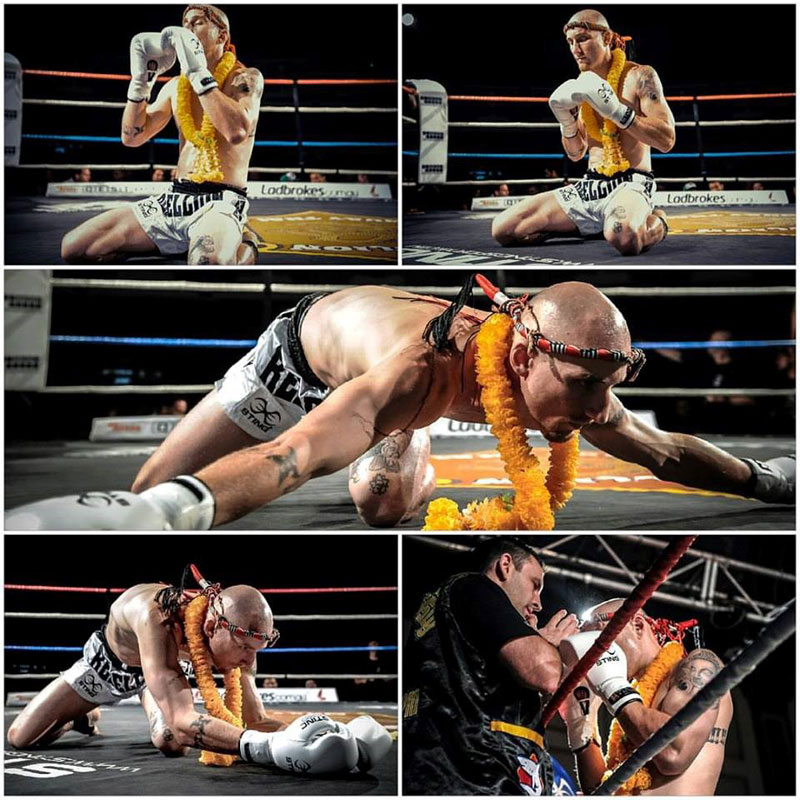
Photo by Lindon-Wotton
From the 15th to 19th centuries, Thailand (then Siam) was in constant conflict with its border neighbour Burma (today Myanmar). The Burmese were seeking to expand their territory and filtered into Siam who naturally retaliated with force.
Muay Thai was developed with the concept that the body can be used as a weapon. It was taught to the Thai soldiers and used in actual warfare. Fast forward to the 21st century, Muay Thai is celebrated as much as it is respected.
Thailand being a religious society, Muay Thai was also infused with spiritual and cultural undertones.

Photo by thaifight_official
The Mongkon worn on the head, the Prajoud on the arm and the Wai Kroo / Ram Muay dances that are performed before each match, have deep meaning within them. Muay Thai truly deserves its place as an art form.

Photo by thaifight official
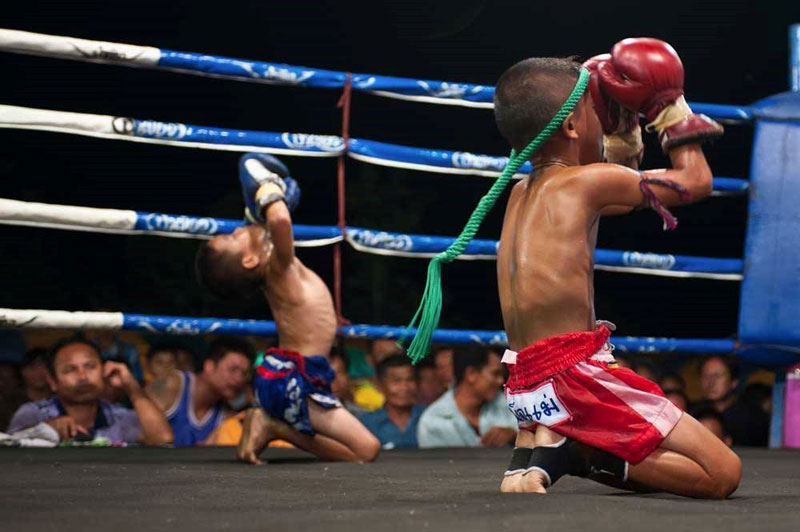
Photo by Allen-A-Hale
In case you’re interested in catching Muay Thai in motion, there are many venues to catch Muay Thai all around Thailand. Book via Klook to conveniently catch the entertaining Muay Thai Live: The Legend Live in Bangkok!
Muay Thai


 简体中文 (Chinese)
简体中文 (Chinese) Bahasa Indonesia
Bahasa Indonesia